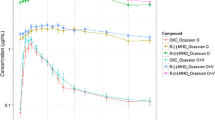Summary
Oxcarbazepine (oxcarb) 600 and 900 mg (2360 and 3540 µmol) was taken by 3 volunteers (2 ♀, 1 ♂; 45–67 kg; age 22–34 years) after an overnight fast. Blood, saliva and urine were collected for the next 72 h for assay of oxcarb, 10,11-dihydro-10-hydroxy-carbamazepine (OHcarb), and 10,11-dihydrotrans-10,11-dihydroxy-carbamazepine (diol). Oxcarb reached a maximum level of about 1 µg/ml (3.93 µmol/l) within 1 h and dropped below the detection limit (0.1 µg/ml=0.39 µmol/l) within 3 h. The active metabolite OHcarb appeared in the blood before oxcarb and reached the higher maximum level of 7.4 µg/ml (29 µmol/l) after 7 h. Thereafter serum levels decreased with a t1/2 of about 25 h, and after 40 h with a t1/2 of 9 h, the latter agreeing with the renal excretory t1/2 calculated from the urine data (10 h). The ratio of OHcarb concentration in saliva to that in plasma varied considerably (0.3–1.7; median 1; r>0.9), whereas that of blood to plasma was 1.25 with only small variation (r>0.98); OHcarb concentrations in erythrocytes were 50% higher than in plasma. Diol was detected in blood (maximum level 0.5 µg/ml=1.84 µmol/l) in 2 volunteers. 45% of the dose could be recovered in urine (Oxcarb 5%, OH-carb 36%, Diol 4%). Whereas Oxcarb was completely conjugated, only 25% of OHcarb was conjugated and diol was unconjugated.
Similar content being viewed by others
References
Baltzer V, Schmutz H (1977) Experimental anticonvulsive properties of GP 47680 and of GP 47779, its main human metabolite; compounds related to carbamazepine. In: Meinardi H, Rowan AJ (eds) Advances in epileptology. Swets and Zeitlinger, Amsterdam-Lisse, pp 295–299
Eichelbaum M, Köthe KW, Hoffmann F, v. Unruh GE (1979) Kinetics and metabolism of carbamazepine during combined antiepileptic drug therapy. Clin Pharmacol Ther 26: 366–371
Faigle JW, Brechbühler S, Feldmann KF, Richter WJ (1976) die Biotransformation von Carbamazepin. In: Birkmayer W (ed) Anfall — Verhalten — Schmerz. Huber, Bern Stuttgart Wien, pp 130–142
Feldmann KF, Brechbühler S, Faigle JW, Imhof P (1978) Pharmacokinetics and metabolism of GP 47680, a compound related to carbamazepine, in animals and man. In: Meinardi H, Rowan AJ (eds) Advances in epileptology 1977. Swets and Zeitlinger, Amsterdam-Lisse, pp 290–294
Feldmann KF, Dörhöfer G, Faigle JW, Imhof P (1980) Pharmacokinetics and metabolism of GP 47779, the main human metabolite of oxcarbazepine (GP 47680) in animals and healthy volunteers. Acta Neurol Scand (Suppl 79) 62: 15
Gibaldi M, Perrier D (1975) Pharmacokinetics. Marcel Dekker, New York, pp 6–16
Hattingberg HM v, Brockmeier D, Kreutzer G (1977) A rotating iterative procedure (RIP) for estimating hybrid constants in multi-compartment analysis on desk computers. Eur J Clin Pharmacol 11: 381–388
Klotz U (1978) Klinische Pharmakokinetik. Gustav Fischer, Stuttgart
Kübler W (1970) Pharmakokinetische Methoden zur Ermittlung der Resorption. Z Kinderheilk 108: 187–196
Passarge Ch (1978) Antiepileptische Langzeitbehandlung im Erwachsenenalter. Dtsch Med Wochenschr 103: 1586–1588
Rai PV, Egli M, Wad N (1979) Serum level studies of oxcarbazepine and its metabolites in clinically effective dosage. In: Proceedings of the 11th Epilepsy International Symposium, Firenze
Schneider H (1975) Carbamazepine: an attempt to correlate serum levels with antiepileptic and side-effects. In: Schneider H, Janz D, Gardner-Thorpe C, Meinardi H, Sterwin AL (eds) Clinical pharmacology of antiepileptic drugs. Springer, Berlin Heidelberg New York, pp 151–158
Theisohn M, Sigmund M, Heimann G, Roth B (1978) Nebenwirkungshäufigkeit und Blutspiegelverlauf von Carbamazepin und seinem antikonvulsiv wirksamen Metaboliten Carb-10,11-Epoxyd nach einmaliger und nach chronischer Gabe. In: Doose H, Groß-Selbeck G (eds) Epilepsie 1978. Thieme, Stuttgart, pp 197–205
Theisohn M, Fröscher W, Hoffmann F (1981) Erste Behandlungsversuche mit Oxcarbazepin. In: Remschmidt H, Rentz R, Jungmann J (eds) Epilepsie 1980. Thieme, Stuttgart, pp 176–182
Wad N, Rai PV, Egli M (1979) Klinsch-chemische und klinischpharmakologische Aspekte von Mephenytoin, Methsuximid, Monohydroxy-Carbazepin (GP 47779) und Pheneturide. In: Jahresbericht der Schweizerischen Epilepsie-Klinik in Zürich
Author information
Authors and Affiliations
Rights and permissions
About this article
Cite this article
Theisohn, M., Heimann, G. Disposition of the antiepileptic oxcarbazepine and its metabolites in healthy volunteers. Eur J Clin Pharmacol 22, 545–551 (1982). https://doi.org/10.1007/BF00609629
Received:
Accepted:
Issue Date:
DOI: https://doi.org/10.1007/BF00609629




